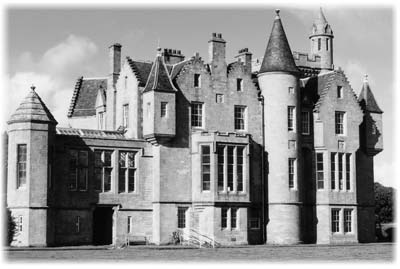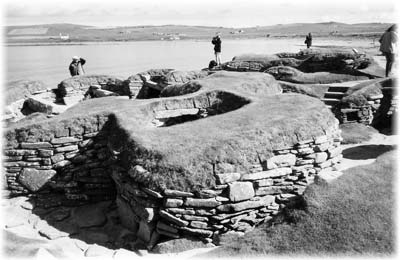Scotland's Orkney Islands
Having completed a cruise on the Caledonian Canal, the Betty and Dick Wood's Scottish journey continues with an Orkney Islands extension.
Following a tour of the lovely city of Inverness, a group of 10 of us boarded a 37-passenger turboprop plane for a flight to Kirkwall in the Orkney Islands.
This group of 70 islands, rising out of the North Sea in the face of furious tides and bitter winds, lies just north of the Scottish mainland. With the exception of Hoy, which is high and rugged, these islands are low-lying, gently sloping and fertile and for centuries have provided a reasonably secure income from farming and fishing.
Accommodations fit for a king
After a drive across East Mainland to St. Mary’s, a former herring fishing village, we hurried the 13 miles back to Kirkwall to make the 4:15 p.m. ferry to Balfour Castle, dramatically set on the sloping shores of Shapinsay Island. Balfour is a calendar castle, with 365 panes of glass, 12 outside entrances, seven turrets and 52 rooms, of which six are used as guest bedrooms.
Our room on the third floor had a large, old-fashioned, brass double bed. The bathroom was located in the corner turret and included both a shower and a large tub. Cocktails were served in the first-floor oak-paneled library, where there was a roaring fire in the large, old fireplace.
We were on a tour of the castle when a loud gong sounded, announcing that dinner was being served in the family dining room. Our meal began with crab, Stromness rye bread and cream soup, followed by Shapinsay wild duck breast with new potatoes and vegetables from the garden and a chocolate tart with Balfour garden raspberries and ice cream.
Wonderful views over Kirkwall Bay and the surrounding fields can be had from the castle, and the large garden that supplies the kitchen with fresh vegetables, berries and fruit year-round is also worth a visit.
Mrs. Zawadski, her two daughters and two grandsons, who now reside in the castle, were very helpful in making our stay a success.
Skara Brae
We returned to Kirkwall on Mainland Island the next morning, where a half-hour drive across the island in bright sunshine brought us to Skara Brae, our first Stone Age site. We were shown a 10-minute video on the history of the site, then took a short walk to the beach to see the remains of the well-preserved small fishing and farming village that was inhabited between 3000 and 2500 B.C.
Discovered in 1850 after a fierce storm exposed the site, the village’s houses, many of which still stand, huddle together and are connected by narrow passages which would have been covered over with sod.
For centuries it was buried in the dunes, which protected a vast array of domestic details, including dressers, fireplaces, beds and boxes, all carefully put together from slabs of stone. It is one of the world’s great archaeological sights, older than the great pyramids in Egypt.
More Stone Age sites
Our next stop was the Ring of Brodgar, a nearly complete ring of 27 large upright stones, varying in height from six to 12 feet, set in a field of pink heather. About a half mile down the road we stopped once more to visit Maeshowe, one of Orkney’s largest passage graves. It dates from 2750 B.C., and its incredible state of preservation is partly due to the massive slabs of sandstone it was constructed from, the largest weighing over three tons.
This whole area was a religious center for Orkney’s Stone Age inhabitants. Of the many remains dating back to the Neolithic period, the closest (only a half mile from the Ring of Brodgar) are the Stones of Stenness, another smaller circle of just 12 rock slabs, the tallest of which measures about 19 feet.
Afterward we visited the Highland Park Scotch Whisky distillery, the most northern Scotch whisky distillery in the world. The tour guide explained some of the details that go into making a fine whisky, and we were treated to a wee dram.
After our last night at Balfour Castle, we drove to Westray Island’s Cross Kirk, one of the best-constructed churches in Orkney, and were fortunate to see the interior and visit the cemetery on the bluff above the water.
Later we drove to the northeast end of the island where there was a very small landing strip in a private field. Within 10 minutes of our arrival, a small 6-passenger Logan Air turboprop arrived. Six from our group got aboard and flew over to the nearby island of Papa Westray, the plane returning for the rest of us in less than 10 minutes.
On the second flight, our time from takeoff to touchdown was exactly one minute and 24 seconds. This is the world’s shortest scheduled commercial flight — it is in the “Guinness Book of World Records.”
Papa Westray lies roughly on the same latitude as Stavanger, Norway, and is home to the oldest house in Northern Europe, located at the Knap of Howar and dating back more than 5,000 years.
The island, just four miles long by a mile wide, is one of the most remote of the Orkney group.
Back to Mainland
The following day we drove across Mainland to the village of Tingwall, the site of the Broch of Gurness. Built about 700 B.C., the broch, with drystone towers that are unique to Scotland, served as protection and storage for the entire village.
Two thousand years ago, Gurness was probably one of the most important settlements in the Orkneys. Today you can still see the remains of its impressive architecture as well as large Pictish farms and Viking burial sites.
A short ferry ride landed us on Rousay, where we drove along the Westness coastline, one of the most beautiful in Orkney. We parked high on a hill, with the famous Westness Walk, established in 1987, far below on the coastline. Leading south for a little over a mile along the beach from the Midhowe Broch to Westness Farm, the walk through fields and over rocky paths takes anywhere from one to 1_ hours.
Off we went down a steep path to Midhowe Cairn, the largest cairn in Orkney. The collective burial places of the communities of Neolithic farmers, who settled in Orkney during the fourth millennium B.C., probably reached their height of development around the first century.
The sun was warm, and this appeared a likely spot for a picnic lunch. It was a beautiful place to enjoy our last full day in Orkney.
Lunch finished, we began the Westness Walk, marked by a number of Viking graves dating from around the ninth century.
Back in Kirkwall, we walked to the Ayre Hotel for our farewell dinner — an extra-special one with crab legs, soup, sirloin steak and a special island dessert.
This trip was booked through Lindblad Expeditions (New York, NY; phone 800/397-3348 or visit www. expeditions.com) and cost $6,690 plus air from Seattle ($1,061 each).




